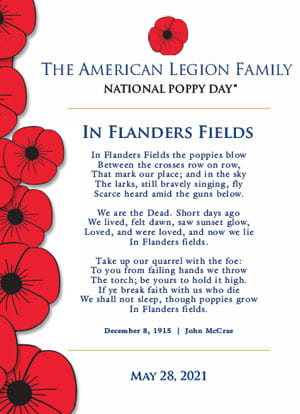Category: History, Holidays, Poetry, Post Feed
Tags: American Legion, Armistice, Helen Teague, In Flanders Fields, John McCrae, Memorial Day, Moina Michael, Professor Moina Michael, STEAM, We Shall Keep the Faith
The Significance of Red Poppies to Honor Those Who Gave The Ultimate Sacrifice

Red poppies have been a symbol of the aftermath of battles. The pairing of Red poppies and mourning for soldiers’ sacrifice has been linked to the Napoleonic war when red poppies (
Palaver rhoeas), would be observed growing over soldiers’ graves.
Professor Michael was professor at the University of Georgia at the time the war broke out, yet she took a leave of absence to volunteer at the New York headquarters of the Young Women’s Christian Association (YWCA). Two days before
the armistice, Professor Moina Michael read the poem
“In Flanders Fields” by John McCrae. The poem was published in the magazine,
Ladies’ Home Journal.
Inspired by John McCrae’s poetic verses, in 1918, Professor Michael wrote her own poem in response, which she titled “We Shall Keep Faith.”
We Shall Keep the Faith
by Moina Michael, November 1918
Oh! you who sleep in Flanders Fields,
Sleep sweet – to rise anew!
We caught the torch you threw
And holding high, we keep the Faith
With All who died.
We cherish, too, the poppy red
That grows on fields where valor led;
It seems to signal to the skies
That blood of heroes never dies,
But lends a lustre to the red
Of the flower that blooms above the dead
In Flanders Fields.
And now the Torch and Poppy Red
We wear in honor of our dead.
Fear not that ye have died for naught;
We’ll teach the lesson that ye wrought
In Flanders Fields.
Professor Michael gave fabric blooms to her academic colleagues to wear in remembrance of soldiers. After the war ended, Professor Michael returned to the university town of Athens, Georgia, and thought about the best way to continue her practice of remembrance.
She began to craft and sell red silk poppies to raise money to support war veterans as they returned to the United States.
Over time, Professor Michael organized a campaign to create a national symbol for remembrance which would be a poppy in the colors of the Allied nations’ flags entwined around a victory torch. At the beginning of 1920, she secured a pledge from Georgia’s branch of the American Legion, to adopt the poppy (minus the torch) as its symbol.
In September, 1920, the National American Legion voted to use the poppy as the official U.S. National emblem of remembrance.
National American Legion (2021). The Poppy Story. https://www.legion.org/poppyday/history
 Red poppies have been a symbol of the aftermath of battles. The pairing of Red poppies and mourning for soldiers’ sacrifice has been linked to the Napoleonic war when red poppies (Palaver rhoeas), would be observed growing over soldiers’ graves.
Red poppies have been a symbol of the aftermath of battles. The pairing of Red poppies and mourning for soldiers’ sacrifice has been linked to the Napoleonic war when red poppies (Palaver rhoeas), would be observed growing over soldiers’ graves.




